How to Track Competitor Price Points: A Strategic B2B Guide
What if your pricing strategy was leaving money on the table—or worse, driving potential customers straight to your competitors? Every year, B2B companies lose an estimated 15% of potential revenue due to ineffective competitive pricing intelligence.
This guide will equip you with systematic approaches to track competitor price points precisely, transforming raw data into strategic pricing insights that can dramatically improve your market positioning and profitability.
For product marketing managers and pricing strategists battling in hyper-competitive markets, understanding your competitors' pricing isn't just a tactical advantage—it's a survival mechanism. By implementing strategic tracking methods, you'll gain the ability to respond swiftly, optimize margins, and make data-driven decisions that keep you ahead of market shifts and customer expectations.
Why Precise Competitor Price Point Tracking Matters for B2B Success
The Strategic Imperative of Pricing Intelligence
Pricing isn't just a numbers game—it's a sophisticated strategic lever that can determine market dominance or obsolescence. For B2B organizations, understanding competitor pricing goes far beyond simple comparison; it's about gaining nuanced insights that inform comprehensive business strategies.
The modern B2B marketplace operates at unprecedented speeds, where pricing dynamics shift rapidly. A 2022 McKinsey report revealed that companies with advanced pricing intelligence mechanisms can increase their profit margins by up to 25% compared to competitors who rely on traditional tracking methods.
Critical Obstacles in Competitive Pricing Analysis
- Data Complexity: Navigating multiple pricing sources, platforms, and formats creates significant analytical challenges
- Information Fragmentation: Competitor pricing information is often scattered across various channels, making comprehensive tracking difficult
- Real-Time Limitations: Manual tracking methods quickly become outdated, leaving businesses reactive instead of proactive
- Technology Barriers: Many organizations lack sophisticated tools or expertise to conduct systematic price monitoring
These obstacles transform competitive pricing tracking from a straightforward task into a sophisticated strategic challenge requiring specialized knowledge and methodical approaches.
Transforming Pricing Intelligence into Competitive Advantage
A comprehensive, step-by-step tutorial addressing competitor price point tracking will empower B2B professionals to:
- Develop a structured methodology for continuous price intelligence gathering
- Leverage advanced digital tools and techniques for efficient data collection
- Create robust frameworks for analyzing and interpreting pricing trends
- Translate raw pricing data into actionable strategic insights
- Build adaptive pricing strategies that respond dynamically to market shifts
By demystifying the process and providing clear, executable strategies, businesses can transform pricing intelligence from a passive observation into an active competitive weapon.
"Pricing intelligence is no longer optional—it's a fundamental requirement for sustainable B2B market competitiveness." - Global Pricing Strategy Association
Step-by-Step Process for Effective Competitor Price Point Tracking

1. Map Your Competitive Landscape
Strategic price tracking begins with comprehensive competitor identification. This isn't just about listing direct rivals, but understanding the full ecosystem of potential pricing alternatives.
- Create a detailed spreadsheet documenting direct and indirect competitors
- Categorize competitors by market segment, product complexity, and pricing tier
- Identify at least 5-7 key competitors across different market positions
Recommended Tools: • Crunchbase for company research • LinkedIn Sales Navigator for competitive intelligence
Pro Tip: Use industry association reports and annual reports to uncover lesser-known competitors with potential pricing strategies.
2. Establish Data Collection Mechanisms
Systematize your price intelligence gathering through a mix of automated and manual research strategies.
- Deploy web scraping tools for real-time pricing updates
- Set up Google Alerts for competitor pricing announcements
- Subscribe to industry newsletters and pricing trend reports
- Utilize price comparison platforms specific to your industry
Recommended Tools: • Prisync for automated price tracking • SEMrush for competitive digital intelligence
Pro Tip: Create a standardized template for recording pricing data to ensure consistent, comparable tracking across multiple sources.
Troubleshooting Common Competitor Price Tracking Challenges

Data Accuracy and Reliability
Common Issues:
- Inconsistent or outdated pricing information
- Difficulty verifying collected data sources
- Hidden pricing structures and complex discount models
Strategic Solutions:
- Cross-reference multiple data sources to validate pricing information
- Implement rolling 30-day verification cycles for pricing data
- Develop relationships with industry insiders who can provide nuanced pricing insights
- Use advanced pricing intelligence platforms with machine learning verification capabilities
Pro Tip: Create a weighted reliability score for each pricing source to mathematically assess data credibility.
Technology and Tool Limitations
Potential Roadblocks:
- High costs of advanced tracking software
- Complex implementation of web scraping tools
- Limited integration with existing technology infrastructure
Strategic Solutions:
- Start with cost-effective, modular pricing intelligence tools
- Leverage open-source web scraping frameworks for custom solutions
- Prioritize tools with robust API integration capabilities
- Consider hybrid approaches combining automated and manual tracking methods
Pro Tip: Allocate 10-15% of your competitive intelligence budget for technology experimentation and tool evaluation.
Interpretation and Strategic Application
Critical Limitations:
- Difficulty translating raw pricing data into actionable strategies
- Overreacting to minor pricing fluctuations
- Lack of contextual understanding behind pricing changes
Strategic Solutions:
- Develop comprehensive pricing scenario models
- Create decision matrices for responsive pricing adjustments
- Establish quarterly pricing strategy review sessions
- Train teams in advanced pricing intelligence interpretation
Pro Tip: Implement a "pricing intelligence dashboard" that provides contextual analysis beyond raw numbers.
Transforming Competitor Price Tracking into Strategic Advantage
By mastering the systematic approach to competitor price point tracking, B2B professionals unlock a powerful competitive intelligence framework that goes far beyond simple data collection.
Key Business Transformation Benefits
- Precision Pricing Strategy - Develop data-driven pricing models that optimize margins and market responsiveness
- Competitive Positioning - Gain real-time insights that enable proactive market strategy adjustments
- Revenue Protection - Minimize potential revenue loss through intelligent, dynamic pricing approaches
- Strategic Decision Making - Replace intuition with quantifiable competitive intelligence
- Operational Efficiency - Streamline pricing intelligence gathering through systematic methodologies
Measurable Success Metrics
- Pricing Margin Variance: Track percentage improvements in profit margins resulting from strategic price adjustments
- Market Responsiveness Index: Measure time between competitive price changes and your strategic response
- Competitive Intelligence Accuracy: Assess the reliability and precision of your pricing data collection methods
- Revenue Impact Ratio: Calculate direct revenue gains from implemented pricing intelligence insights
"Strategic pricing intelligence transforms market data into your most powerful competitive weapon." - B2B Pricing Strategy Consortium
Conclusion: Transforming Competitor Price Tracking into Strategic Advantage
By implementing a comprehensive and methodical approach to competitor price tracking, B2B pricing strategists can unlock unprecedented market intelligence and competitive positioning. The strategic integration of advanced tracking technologies, data analytics, and continuous monitoring enables organizations to not just react to market changes, but proactively shape their pricing strategies with precision. Remember that effective price tracking is more than collecting data—it's about transforming raw information into actionable insights that drive strategic decision-making, optimize profit margins, and maintain a dynamic competitive edge in increasingly complex market landscapes. As technology and market dynamics evolve, maintaining an adaptive, technology-driven approach to competitor price tracking will be crucial for sustained business success and strategic differentiation.
